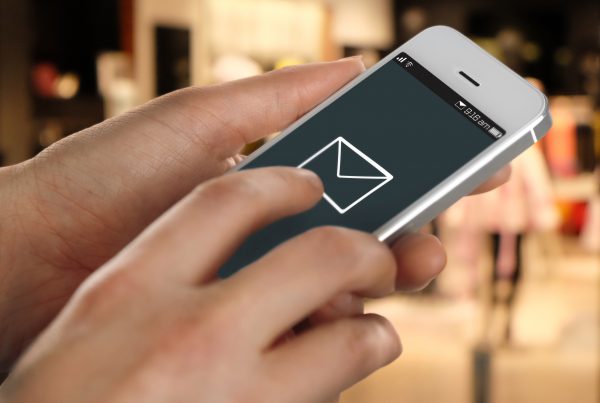In a fragmented communications landscape, companies have to fight hard for consumer attention. From a marketing and customer engagement perspective, this can be exhausting.
SMS has, of course, been around for nearly three decades. During that time, it’s evolved to become one of the most valuable go-to-marketing channels available. Marketers choose to keep using SMS to interact with their customers because it’s reliable, cost-effective, and easy to use. In fact, SMS has a noticeably higher open rate than email.

However SMS hasn’t evolved at all to keep up with changing customer expectations and business marketing needs. Why? Simply put, because messages are still text-based.
It would be a bit of an understatement to say that consumers today are empowered, not to mention digital natives. Naturally then, they require (and are seeking) a plethora of content and targeted marketing messages, on their terms, of course. It doesn’t end there-the content has to be tailored to suit their requirements, in a convenient way, needless to say. Therefore, applications like WhatsApp, Facebook Messenger, iMessage, WeChat, Slack, Skype, Viber, Android Messages, et all, fill that gap with an experience that builds on SMS. They assist in sending the right message, at the right time, employing the right media that is relevant, visually appealing and engaging content. It’s no wonder that these feature-rich applications have taken off.
 This is where Rich Communication Services (RCS) comes in. It enables text messaging to be as engaging as WeChat, WhatsApp, et all. Not just that, it provides “reach” worthy of SMS and MMS. The result-a plethora of opportunities to seamlessly engage with customers! Rich features like photo and video sharing, map directions, location sharing, among others is perfect for businesses looking to engage with consumers in increasingly ’sticky’ ways.
This is where Rich Communication Services (RCS) comes in. It enables text messaging to be as engaging as WeChat, WhatsApp, et all. Not just that, it provides “reach” worthy of SMS and MMS. The result-a plethora of opportunities to seamlessly engage with customers! Rich features like photo and video sharing, map directions, location sharing, among others is perfect for businesses looking to engage with consumers in increasingly ’sticky’ ways.
As a quick reckoner, RCS is a next-generation SMS protocol being championed by industry heavyweights such as the GSMA, Google and Android, Samsung, and their ilk. And for businesses, the recently released RCS Business Messaging opens even more doors for customer engagement, marketing, and sales.
 RCS is a protocol between mobile operators and phones. It is an evolution in mobile messaging, increasing and improving the ways in which people and businesses communicate. It provides a deeper level of engagement compared to SMS; that is conversational, useful and engaging and would serve as ubiquitously being the default messaging clients on most Android devices.
RCS is a protocol between mobile operators and phones. It is an evolution in mobile messaging, increasing and improving the ways in which people and businesses communicate. It provides a deeper level of engagement compared to SMS; that is conversational, useful and engaging and would serve as ubiquitously being the default messaging clients on most Android devices.
It is poised to become a key messaging channel for conversational consumer engagement with brands and enterprises, using enterprise or application-to-person (A2P) messaging, chatbots, and artificial intelligence (AI).
The Rise of RCS
Since its first release in 2008 and until 2011, there was no real mobile operator support to RCS.
Fast-forward to November 2016, P2P Universal Profile RCS messaging was released, followed by the mid-2017 release of the Universal Profile 2.0, a simpler unified standard with significant support from Google and Samsung, among other technology platforms.
But why should businesses consider RCS in their mobile communications? For starters, these stats provide a compelling case.

RCS provides businesses with opportunities that can address and serve customers making B2C interactions more user-friendly whatever the device they have. RCS makes it easier for companies to get their customers to stay engaged. Today a customer can receive promotional marketing, book appointments, make payments, receive documentation and itineraries and even receive important notifications and alerts.

Early adopters of RCS in P2P
According to the GSMA, there are currently over 50 operators among another 20 international manufacturers phone manufacturers that support RCS. Together they serve nearly 160 million users globally.
And Enterprise (A2P) RCS is driving 80 per cent of SMS messaging in the B2C space. These adopters include telecom, banking/financial, travel and logistics, social & entertainment, consumer brands, among many more.
On the device front, more than 80 per cent of Android devices smartphone already support or can support UP-based RCS. In fact, the Android Messages application fully supports UP 2.x and many OEMs are making that it their default messaging app to leverage the technology and experience that Google has been spearheading with RCS recently.
RCS Business Messaging Takes A2P Messaging Even Further
With companies like Google taking the lead through its Early Access Program, brands and developers can now access and adopt RCS business messaging more easily. GSMA estimates, that there will be a billion RCS users in 2019 and the RCS Business Messaging market will be worth over $74 billion by 2021
Today businesses can move beyond basic texting with a cost-effective RCS messaging and engage more users than ever.
B2C companies of all sizes can create truly branded conversations across networks and device. While it provides the macro benefits across all industries, its applications within each industry or environment can be quite versatile and scalable. Marketers can now know how messages are performing with real-time data on user actions and behavior along the customer journey.
For P2P messaging, WhatsApp or other social/chat applications are most likely the predominant channels and not the SMS or operator messaging. However SMS is still by far the strongest B2C channel out there. And RCS aims to be the next level evolution of SMS.
In conclusion: What’s next For RCS and Enterprises
- RCS will evolve to be a favorite channel for enterprises and allow them to
- Send branded messages and conversations
- Share rich media content: such as images, videos or PDF documents
- Drive engagement with suggested replies and actions
- Track message delivery
- Use powerful reporting and analytics to optimize future messages
Through this, there is no longer a need to download multiple apps; instead, users gain direct access to a range of brands and services from within the native messaging app itself,
allowing them to engage with virtual assistants to promote and consume VAS and other operator offerings, book flights, buy clothes, book restaurant reservations and more.
With RCS one is already starting to see some innovative and engaging ways business marketers are employing it. In its attempt to “future proof” businesses, brands will be better able to harness their dialogue and interaction with the consumers and community alike.
Factors Propelling the Uptake of RCS
- Greater reach with the latest release of the Universal Profile would bring more telecom operators and companies worldwide to sign up.
- Universal support on Android devices would slowly also extend to iPhone users who currently do not have the same rich experience.
- Less fragmentation has been arrested significantly with the Universal profile as the primary standard. While P2P usage has been evident, Google’s has helped created a significantly stronger momentum to the A2P play.
- SMS will still be a strong and growing viable B2C/C2B channel until 2023 however with a new milestone businesses will gravitate toward RCS as their primary messaging channel a new milestone, with the number of users surpassing 215 million.
RCS has the potential to change the way the consumers interact with brands in the coming years. While many messaging service providers offer solutions around SMS, only a smaller subset offers true multi-channel solutions that include social or chat applications along with SMS. The number of operators supporting A2P RCS will only increase in the next 12-24 months and we will witness some real interesting enterprise and brand launches. Whatever the timeline, A2P RCS is poised to become a significant channel for consumers to utilize and interact with businesses.






